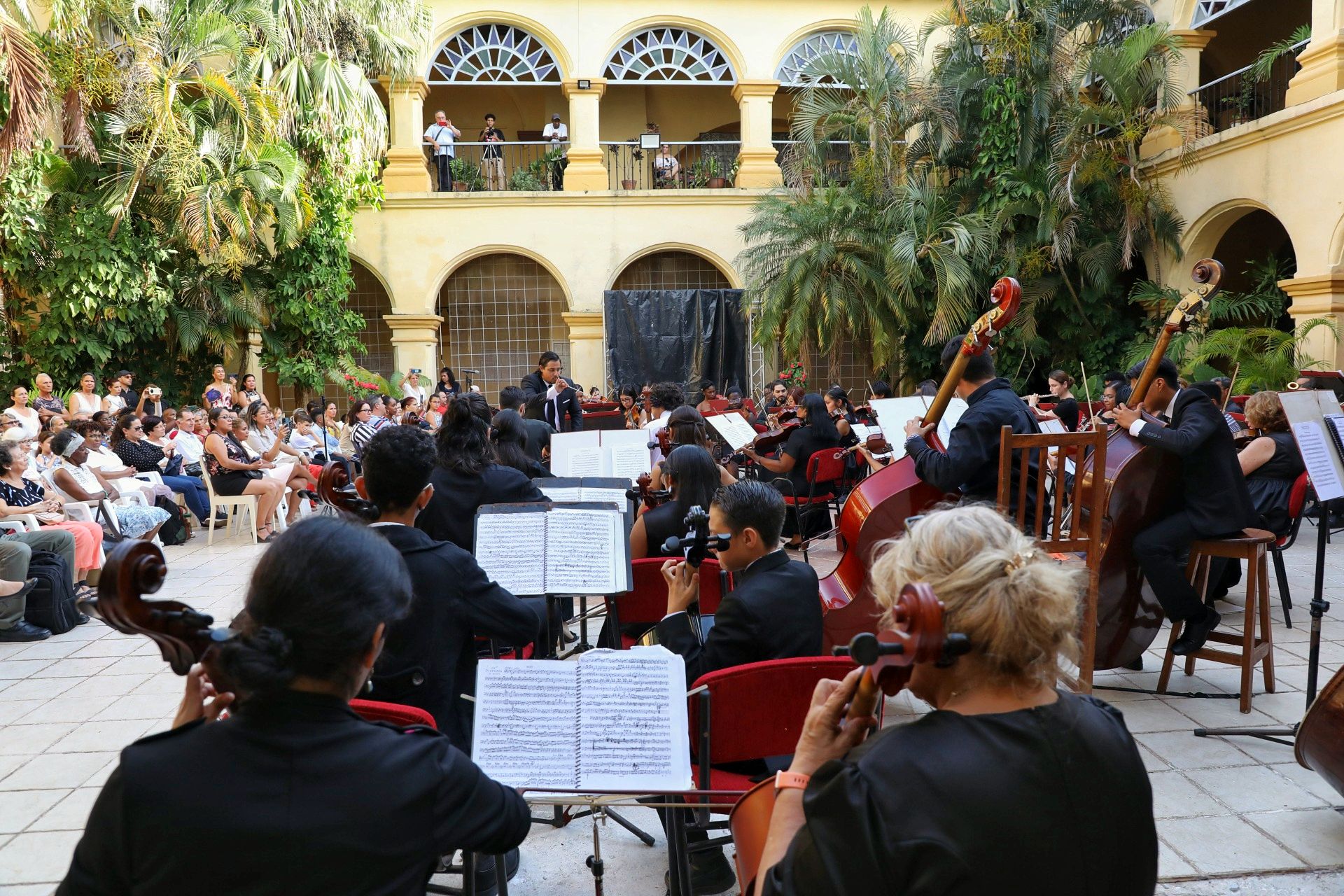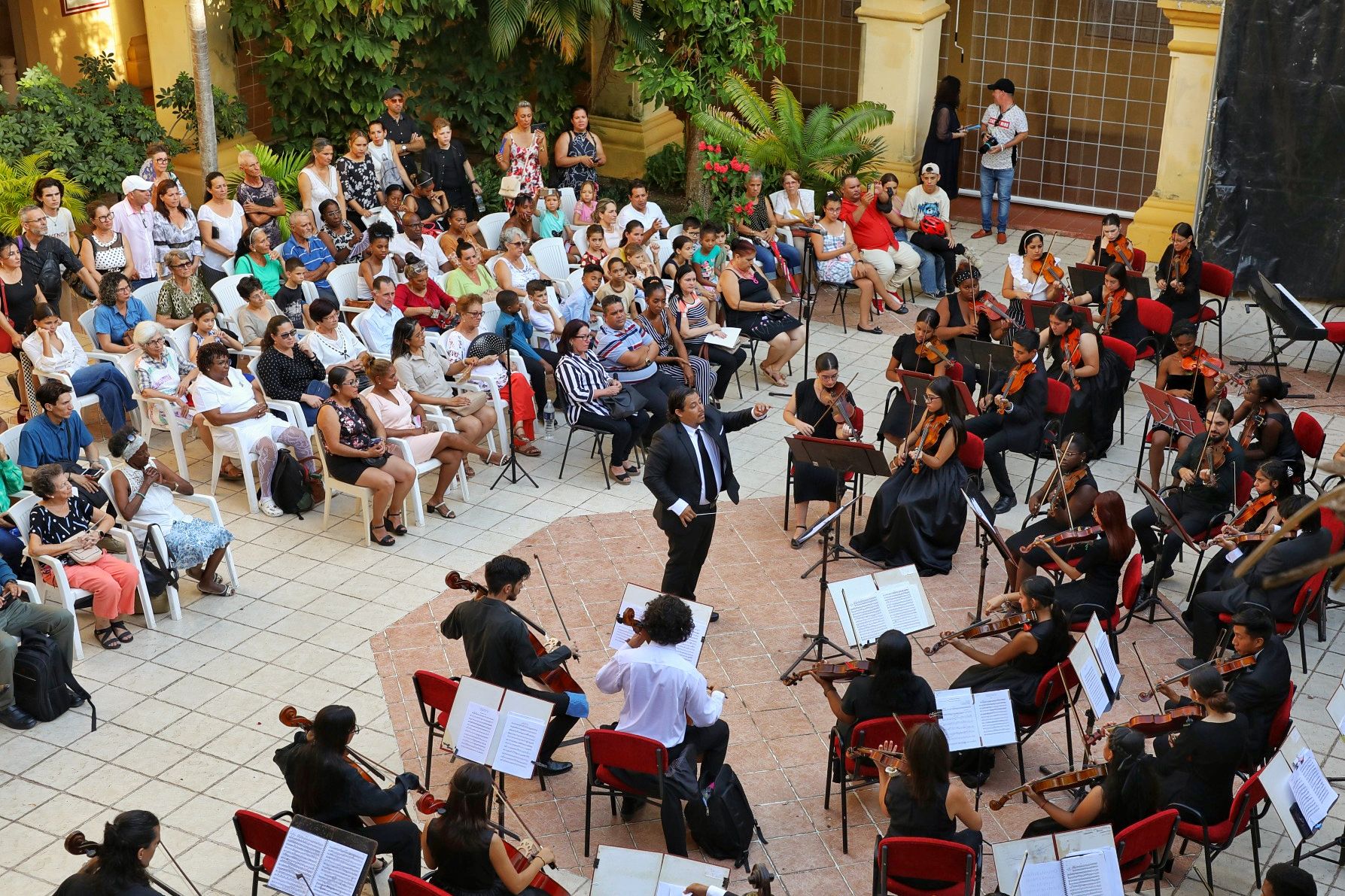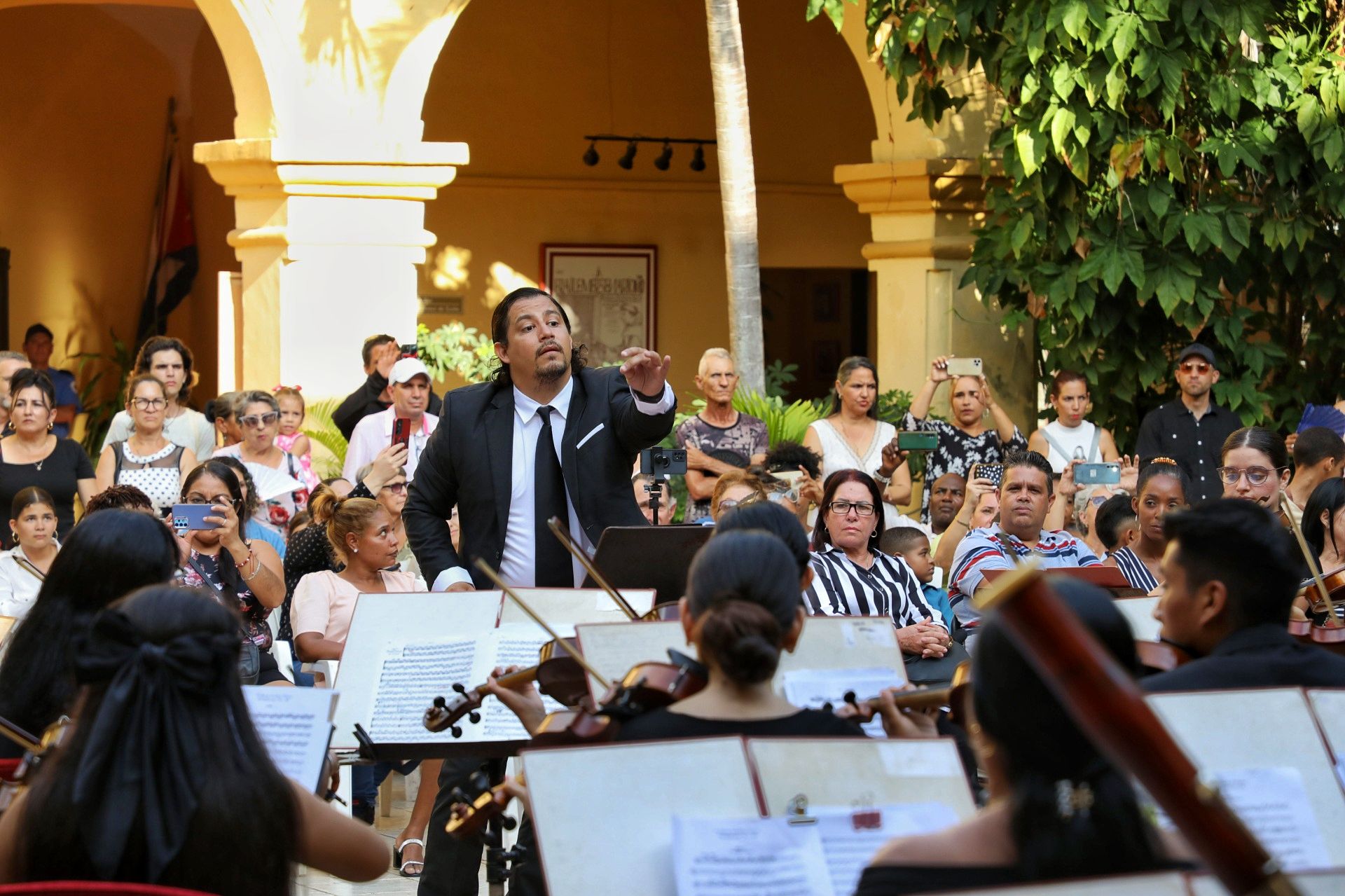CAMAGÜEY.— It was unlikely—but it happened. Because the truly extraordinary happens when everything seems to be against it. Such was the farewell concert of the Mexican delegation from the United Orchestras for Peace Project, which, together with the Camagüey Symphony Orchestra, offered an unforgettable afternoon in the courtyard of the Office of the Historian of the City—a place of architectural beauty transformed into a stage for a poetic act of resistance.
Originally scheduled for the Avellaneda Theater, the concert had to be relocated due to the region's energy crisis. But the open courtyard offered no guarantees either: around five in the afternoon, just as the music was set to begin, heavy raindrops forced the orchestra's chairs to be removed, the instruments to be sheltered, and the audience to shift with their own seats—as if each person were defending their place in the miracle about to unfold. An hour later, with no certainty but full of resolve, the concert began under the baton of Venezuelan conductor Gerardo Reyes Velázquez. What followed was a true drama of the spirit.

MOZART UNDER THE STORM
Mozart’s Symphony No. 40 opened the evening with a refined selection of works reflecting the diversity of Western and Latin American symphonic traditions. It was a piece of shadow and fire, performed with admirable focus despite the suffocating heat, birds flitting between the columns, and a sky that couldn't make up its mind. At the end of the first movement, spontaneous applause broke the liturgical silence of chamber music. The conductor kindly asked the audience to wait until the end to applaud. But those “imprecise” applauses were deeply human—an expression of accumulated exhaustion, sleepless nights in the heat, cooking with charcoal like in another century. Applause as a collective sigh.
THE MUSE OF HUASCA
Then came the international premiere of La musa de Huasca by Mexican composer Roberto Aguilar Arellano, who also performed on piano. The piece—an exploration of Latin American rhythms—moved audiences with its freshness and cultural grounding. Unusually for a symphony concert, a guitar orchestra was added, giving voice to popular Mexican roots. Among the performers were familiar faces from the delegation: Alondra Barquera, project coordinator and government official from Hidalgo, with her cello, and Mónica Janette Autrique, director of the Praderas School, with her violin. They were active parts of the performance.
Maestro Eduardo Campos, director of the Camagüey Symphony, described the work as “an epic journey through the musical history of our America,” with passages of pasodoble, bolero, waltz, sevillana, and huapango, all wrapped in colorful and emotional orchestration. “It has a strong Mozarabic influence that evokes Andalusian liturgy,” he explained—a deeply emotional and intimate moment within the piece.
“In my music, you won’t find a technical situation, but an emotional one,” said the composer, who has dedicated years to reviving traditional rhythms and bringing them into the symphonic language.
La musa de Huasca shines with its light, and it is an honor that Cuba was chosen to launch its international journey. Written over a year, the piece had been previously performed in Mexico and Costa Rica. The choice of Camagüey was no accident: Aguilar Arellano praised the city’s cultural weight and artistic vitality. “Art flows here—there’s a very alive artistic energy,” he said.
The 15-minute piece unveils a rich and expressive palette of timbres. Its spirit is captured, for instance, in a violin solo originally played in Mexico by a young woman from Huasca de Ocampo, the village that inspired the piece. “It’s not about many notes, but about making people feel something with just a few,” said the composer, who began his musical path on guitar, as a piano was beyond reach.
The story behind La musa de Huasca is rooted in the imagery of Huasca, the first town officially recognized as a Pueblo Mágico (Magical Town) in Mexico—a place of legends, waterfalls, and still-active silver mines. It’s said that a silver road was even built there for Emperor Maximilian of Habsburg to cross. Aguilar turned this mythical weight into music.
The piece unfolded like a journey, held together by a vivid musical texture where brass and percussion conveyed an epic and ceremonial tone. At times, it felt as if the orchestra were narrating a legend—each strike, each wind entry, part of a sonic storytelling.

THE MISSION OF MUSIC
“Music must not remain only on the stands. It must go beyond,” said conductor Gerardo Reyes Velázquez, a Venezuelan living in Mexico and one of the driving forces behind this initiative, which brought together youth from Huichapan, Tecozautla, and Tepeji del Río in a youth orchestra that traveled to Camagüey to share humanity.
Reyes Velázquez emphasized music’s mission beyond aesthetics: “It’s not about one person, one town, or one region—it’s a global issue.” He highlighted the real richness of this gathering as a human exchange. “It’s been a warm, beautiful, noble experience.”
The young musicians didn’t just share rehearsals and scores—they also took part in master classes and knowledge-sharing with the seasoned musicians of the Camagüey Symphony: “We can always learn from each other—especially from extraordinary musicians like these. The performance level here is outstanding—truly remarkable.”
Camagüey has become a symbolic home for these visiting musicians. “I’d never been to Cuba before, but I feel at home,” said the Venezuelan maestro. His emotion and gratitude were palpable: “I hope this is just the first of many collaborative efforts we can undertake together in the near future.”

THE EXPANDED EPIC
After La musa de Huasca, the epic theme swelled with Tchaikovsky’s 1812 Overture, a demanding piece even for professional orchestras, performed here with passion despite the heat, fatigue, and over an hour of intense music-making.
And when the evening seemed to call for relief, came Pérez Prado’s Mambo, conducted by Eduardo Campos—a moment of joy. The orchestra stood up in sections, swaying to the rhythm and engaging the audience. It was the most festive, almost cinematic moment of the concert—another collective release, where Cuban music found its most natural space.
Finally, Reyes Velázquez returned to the podium to close the concert with Arturo Márquez’s Danzón No. 2—a blend of elegance and strength that has become a Latin American anthem. The piece alone embodied the sonic brotherhood between Cuba and Mexico.
Before the final notes, the visiting delegation received small clay tinajones—a symbol of Camagüey’s identity. One by one, children, youth, and teachers were recognized with a tangible memento of their grand experience. The gesture, simple and beautiful, captured the spirit of the project: to share, to plant connections, to celebrate music as a universal language.
As part of Camagüey, Eduardo Campos recalled the late oboe player Jorge Rivero Tirado, former principal conductor of the Camagüey Symphony and resident of Mexico, crediting him as the seed of this gathering of United Orchestras for Peace in the city.
It was an admirable concert—not only for its exceptional musical level, but for withstanding the weather, blackouts, poor sleep, and exhaustion. The adult musicians brought academic poise, but the children and teens—Mexican and even one Venezuelan teen—performed with a stirring dedication. With professionalism, attentiveness, and deep respect for the repertoire, they honored the stage. In every sense, it was an act of love.
Translated by Linet Acuña Quilez



